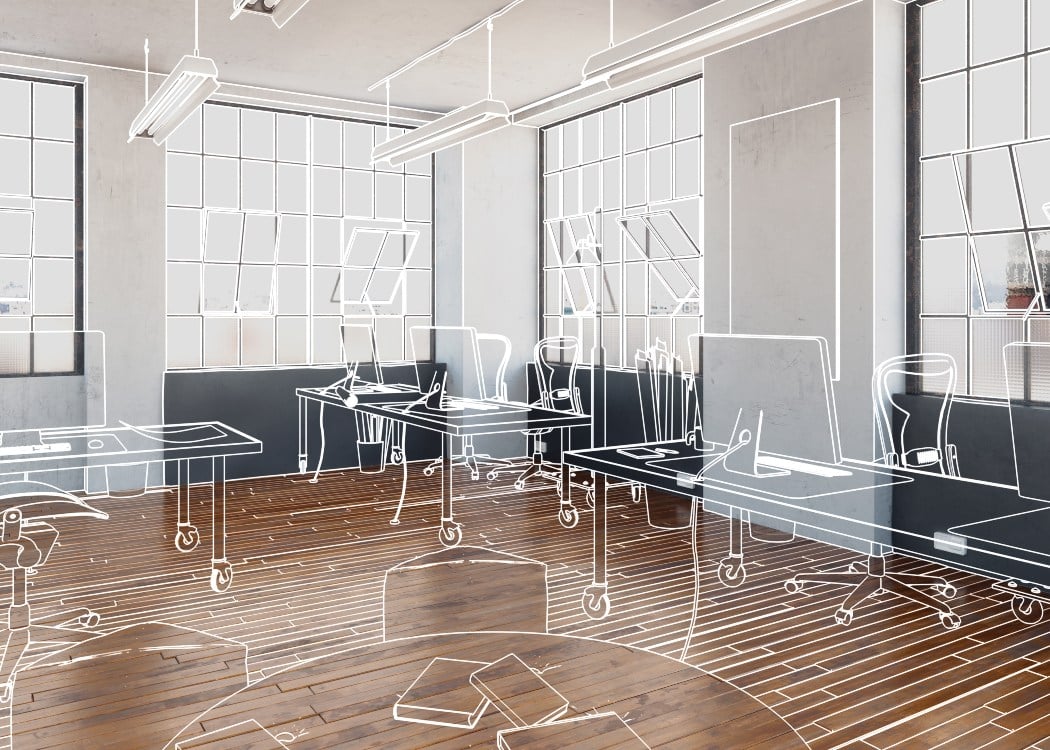
Let us help you with finding an office space
Our experts are here to help take the hard work out of finding your next office space.

As England’s restrictions around travel, COVID passes and working from home seemingly end for good, millions of workers are returning to their offices. But after almost two years in constant flux, and new working patterns transforming day-to-day business, are these workplaces still fit for purpose?
The rise of flexible and hybrid working has changed the function of the office, most likely forever. Once designed to help staff get their heads down and work, the purpose of the office is increasingly to provide opportunities for staff collaboration and social interaction. When workers do come into the workplace, they can form closer bonds and work more productively than ever.
As the world of work adapts, so should your office space. And whether that means adjusting your existing office or moving to a new one, let’s examine how you can move with the times.
As the history of the office tells us, workplaces have thankfully evolved from factory-like grids that wallowed in bureaucracy, to large biophilic spaces harnessing the benefits of natural light and plants. But when workers moved into their bedrooms or kitchen tables during lockdown, they experienced a new level of freedom—one that’s going to be tough to climb back down from.
Now, employees expect to have control over their working day. Just like when they work from home, they want to have a say in an office’s temperature. The noise levels. Even the times that they start and finish. To support your staff in their return to the office, and boost talent retention in the face of the ‘great resignation’, you need a workplace that allows for such freedoms.
Often, giving staff extra control requires simple changes. For example, increasing office open hours provides greater flexibility, helping employees manage work time around their personal commitments, like childcare. You could introduce a booking system, which enables workers to reserve private areas or rooms that give them the space and quiet they need to deliver their best work.
Some businesses are leveraging technology to help improve autonomy and overall experience for their employees.
There are now mobile applications which include smart booking systems, allowing workers to reserve desk space, see which colleagues are also in the office that day, and to book meeting rooms quickly and easily. All of which help employees to collaborate, deliver their best work and get the most out of the office amenities.
The use of technology in buildings does not stop there. Using a combination of sensors and other IoT devices, heating and cooling spaces is now ever smarter. AI monitors sensor data—on temperature, light, CO2, and more—to automatically create optimum workplace conditions and manage energy consumption as efficiently as possible.

With smart technology integrated into their workplace, business leaders can improve productivity and employee experience.
It’s likely that your office now caters to workers who split at least some of their hours between the workplace and their home. So, you’ll also need to invest in tools and processes that enable seamless transitions, remote collaboration, and a positive employee experience.
First, your IT and connectivity must be seamless—able to safely withstand increased levels of interaction between the workplace, remote workers, and even clients too. After all, there’s nothing worse than your screen freezing during an important meeting, or not being able to access certain files, whether you are in the office, at home, or in a third space, like a coworking space or a local cafe. Security is crucial too, with research revealing nearly three-quarters of small businesses are at risk of succumbing to a cyberattack.
In the office, meeting rooms should be equipped with private phone booths, as well as video-call facilities for larger groups. Sometimes this can require a full redesign. Microsoft has introduced specialised conference areas featuring curved desks, eye-level cameras, and intelligent mics and speakers that make participants feel like they’re in the same room.
As employees enjoy greater freedom at work, they may begin to pick when they come into the office more purposefully, such as to attend large-scale team brainstorming sessions. As a result, your layout must also be agile—ready to change to suit each day’s demands.
Office furniture like desks should be lightweight and mobile. That way, they can be combined into large co-working spaces for collaboration or moved into more private rooms when required. With fewer workers visiting the office every day, perhaps you can even discard some of your desks and convert your newfound space into break rooms, games rooms, or other changes you feel will benefit your business.

Office layouts must be flexible to suit the ever-changing needs of hybrid workers.
The pandemic shone a brighter spotlight on the importance of health and safety, both at work and in our personal lives. To reassure employees and welcome them back to the office, it’s best to continue with some low-level safety measures where appropriate. Touchless technology, for instance, can replace buttons and handles around the office, reducing employee concerns regarding viral transmission.
Your workplace may also require an improved ventilation system, not just to reduce the spread of COVID or even common colds, but to boost productivity. Harvard researchers have found that workers’ performance dramatically drops when they breathe in common office concentrations of airborne pollutants like CO2.
Then there are psychological factors to consider, too. After two years of pandemic-related worry, many staff will need extra support when returning to the office. But aside from introducing new policies such as mental health days or regular social events with colleagues, reorganising your office layout can also have a big impact on worker wellbeing.
A bright, open workspace helps us feel relaxed and more at one with nature, especially during winter seasons when reduced exposure to light can cause mental health problems like Seasonal Affective Disorder (SAD). Collaborative desk layouts that encourage colleagues to mix and interact help them to share problems and find solutions together too, reducing work-related stress.
Plus, breakaway zones or rooms allow staff to take breaks during lunch or work time. This is important for the same reasons mental health leaders discourage people from working from their bedrooms. Without different areas dedicated to working, living, playing, and relaxing, we’re unable to fully switch off.

When your workers lead healthy lives, your business thrives.
Many workplaces may no longer meet post-pandemic employee expectations. This will start affecting organisation’s ability to attract and retain the best talent.
Managing office space just got a lot harder, and companies are looking to outsource this burden to specialist operators. This has helped to drive demand for serviced offices and managed office space, where an expert takes responsibility for delivering a first-class office experience.
If you are wondering how your office compares to the competition, or if you already know it’s time for an upgrade, Knight Frank is here to help. Please just ‘get in touch’.
Get your monthly dose of workplace insights, productivity hacks and business leadership ideas - delivered straight to your inbox.

Our experts are here to help take the hard work out of finding your next office space.